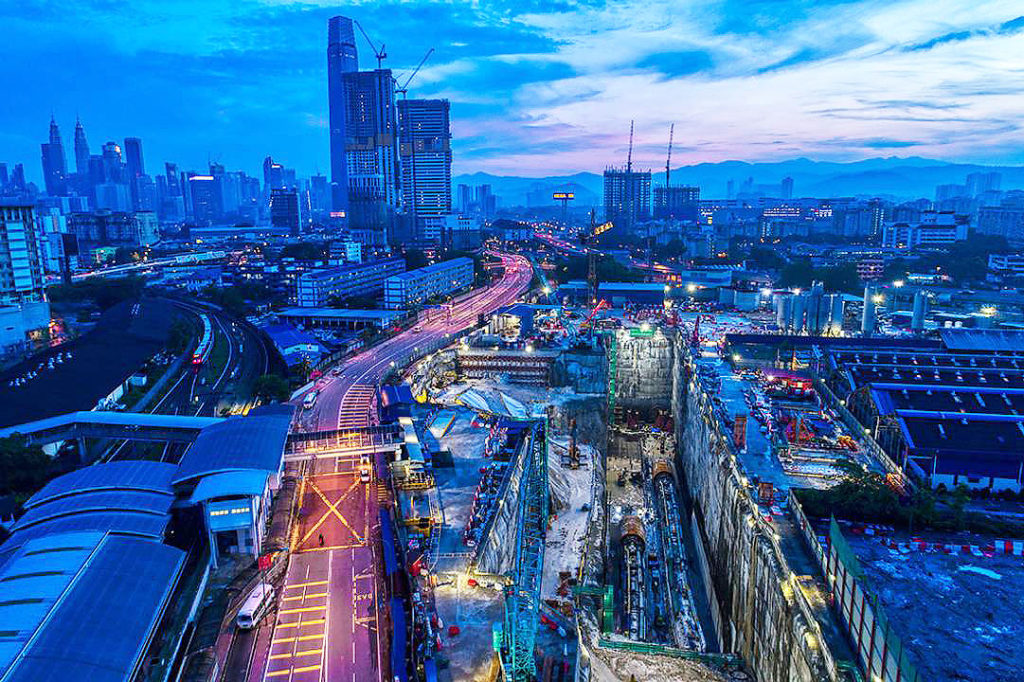Gamuda delivers another success on Malaysian railway project

On 11 October 2020, the last of the tunnel ring making up the 13.5-km stretch of the Klang Valley Mass Rapid Transit (KVMRT) twin bored tunnels was finally completed. Part of a 52-km alignment known as the Putrajaya Line, it is the second extension to the first Kajang Line, and also Malaysia’s first metro network aimed to connect satellite towns to its capital city, Kuala Lumpur (KL).
The job required eight units of variable density (VD) tunnel boring machine (TBM), four units of earth pressure balance (EPB) TBM, 16,000 tunnel segment rings and thousands of workforce for the construction of 11 underground stations – doubling as TBM launching and retrieval shafts – and other ancillary structures. It is no small feat, bearing testament to the ingenuity of its contractor, Gamuda Engineering (GE).
Overcoming difficult challenges
On the project, GE once again faced difficult challenges of tunnelling in KL. In the Kajang Line, there were seven underground stations and 9.5 km of twin tunnels involved, many of which were nestled in KL’s notorious karstic limestone. This time around, the Putrajaya Line tunnels are deeper, with more complex geological interfaces between Kenny Hill, KL Limestone and even an abrasive granite region – not present on the Kajang Line – where frequent, almost daily stops were required to replace worn TBM cutting tools and carry out preventative maintenance.
Besides the more complex geology, the Putrajaya Line tunnels also traverse close to critical infrastructures, such as major railway lines, elevated transits, and even GE’s past projects, the Stormwater Management and Road Tunnel (SMART) as well as the Kajang Line tunnels.
Despite all the challenges above, the entire Putrajaya Line is on track for full opening by January 2023, said GE. The company’s leading tunnel specialist, Gusztáv Klados, who has been with GE for almost 20 years, commented, “When we started with the Stormwater Management and Road Tunnel (SMART) project in 2002, a lot of people told us we were crazy, we can’t build a tunnel in the middle of KL.”
Yet, with adequate preparation and collaboration with the TBM manufacturer, Herrenknecht, through which GE engineers experienced first-hand how to assemble a TBM, the job was delivered successfully. “Once we were awarded the construction of the first MRT Line (Kajang Line) tunnels, we had to build on the capabilities of the people who were with the company and nurture local knowledge and talent,” said Mr Klados. “In fact, it is with such capabilities and commitment to the task that the VD TBM was developed to tackle the challenging geology of the Kajang Line.”
Ng Hau Wei, head of tunnels at GE highlighted that “continuity of the project from SMART to the Kajang Line and now to the Putrajaya Line definitely kept us in momentum, but it ultimately boils down to having the right set of people and the best machines.”
‘Best machines, right people’
In the Putrajaya Line, GE stepped up its game further, breaking the frontiers of construction technology with the introduction of the world’s first autonomous TBM system. Dubbed A-TBM, this system was plugged into 10 of the TBMs used in the Putrajaya Line to boost overall productivity, safety and quality of tunnel construction using artificial intelligence.
“With the VD TBM, we could switch between multiple slurries and EPB modes with ease in a single drive. With the A-TBM system, the possibilities are endless as we now have supervision over tunnelling parameters and operations for multiple machines simultaneously, at the speed and accuracy of a computer,” explained Mr Ng.
The A-TBM has won two prestigious international innovation awards in 2019, namely the Technical Equipment Innovation of the Year Award at the 2019 International Tunnelling and Underground Space Association (ITA) Tunnelling Awards in Miami, Florida and the Innovation in Tunnel Excavation Award at the Tunnelling Festival Awards in the UK sponsored by the British Tunnelling Society.
As for the “right set of people”, both Mr Klados and Mr Ng commended the aptitude and agility of GE’s expertise with project management. In one example, a TBM codenamed S-777 was initially intended for a tunnel drive between two stations only. Due to unforeseen delays, a recovery plan was introduced – upon breakthrough at its original destination, the TBM would be pulled across the station box and launched from the other end to make up for lost time. The scheme proved successful as GE’s impressive project milestones have shown.
Another example is the management’s commitment to staying ahead of the Covid-19 crisis amidst construction. Many control measures were strategically applied early on throughout the mega project and have proven successful in safeguarding GE’s workforce from possible breakouts.
The contractor’s capabilities even extend to that of tunnelling machinery. The Putrajaya Line tunnels were in fact built with several TBMs from Kajang Line refurbished by the contractors themselves. “As we speak, 11 TBMs from the Putrajaya Line are already being carefully stored and maintained at our refurbishment facility in anticipation of upcoming tunnelling projects,” said Mr Ng.
With the remainders of the Putrajaya Line underground station construction finishing soon, GE is ready to move on to other complex tunnelling projects, be it in Malaysia or elsewhere. As Mr Klados summed it up, “Our technical knowledge is convertible … there will be other places where we have an opportunity and we will have a good chance of getting jobs.”
Gamuda Engineering (GE) is a wholly-owned subsidiary of Gamuda Berhad, which is part of the joint venture MMC Gamuda KVMRT (T) Sdn Bhd (MGKT). MGKT is the appointed underground works package contractor for the Klang Valley Mass Rapid Transit Sungai-Buloh-Serdang-Putrajaya Project.

